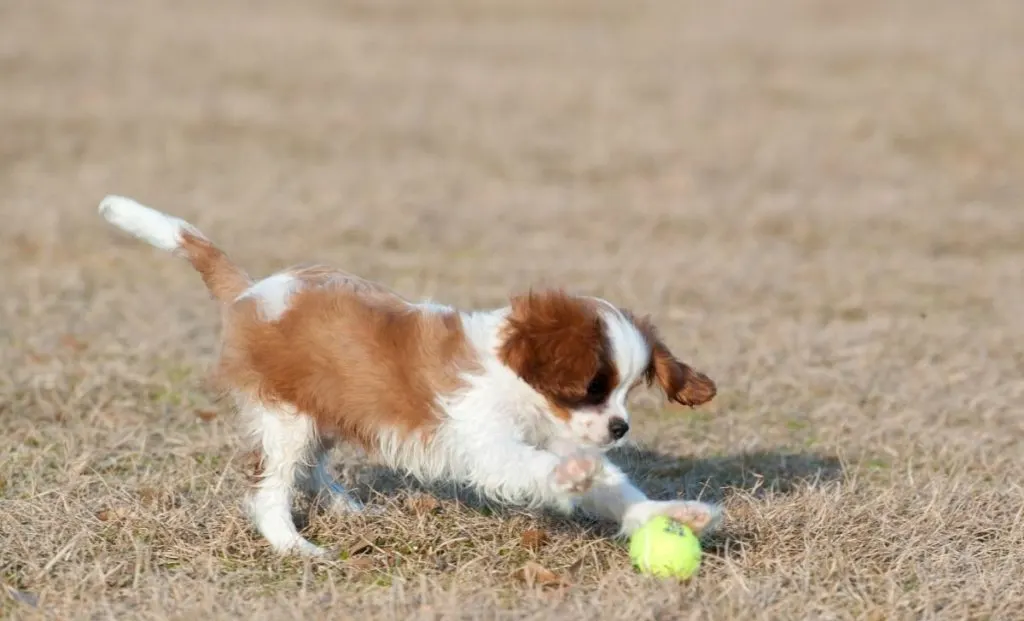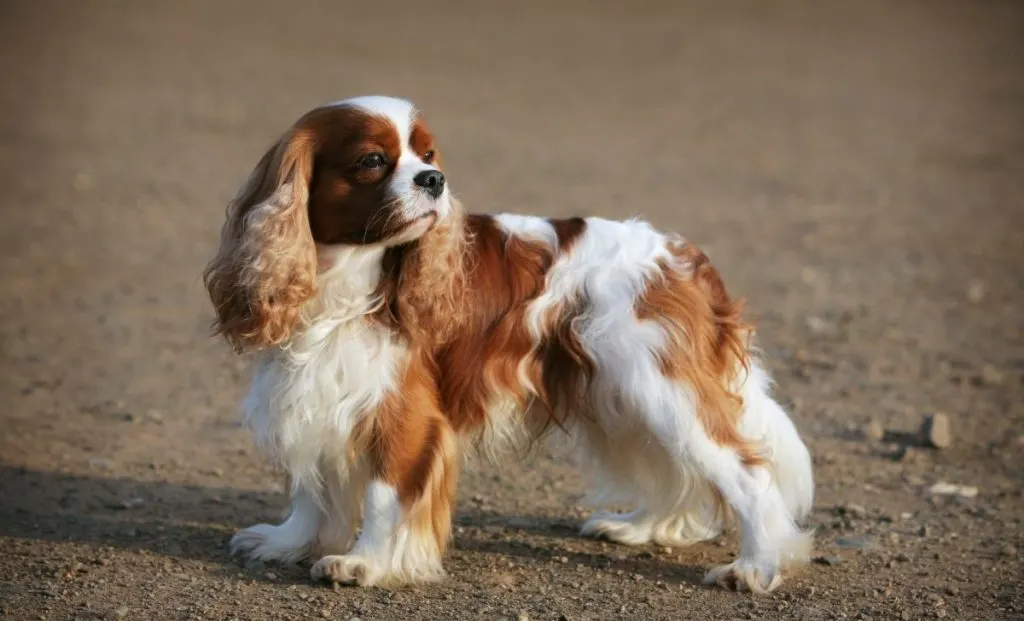The Cavalier King Charles Spaniel is a beloved toy breed known for its affectionate
nature, expressive eyes, and elegant appearance.
If you have a plan to bring home some adorable Cavalier King Charles Spaniel puppies, it is very important to understand all the growth stages of this dog breed.
Thanks to that knowledge, you can provide appropriate care and ensure the optimal development of your pup later on.
This article provides an in-depth look at the Cavalier King Charles Spaniel’s growth stages throughout their different weeks of age, including weight and height charts to help you monitor your dog’s development.
We also covered all the essential Q&A about your growing puppy that you might want to know. Now, let’s learn more about these adorable, tiny dogs.
The Weight and Height Charts

To even understand the development phases of the Cavalier King Charles Spaniel that we are going to talk about, we must examine their weight and height charts first.
To better understand the growth of a Cavalier King Charles Spaniel, refer to the following charts, which provide average weight and height ranges at different ages.
Cavalier King Charles Spaniel Growth Chart for Males
Below is a detailed growth chart for male Cavalier King Charles Spaniels, tracking weight and height from birth until their second year of life.
The chart includes measurements in both imperial and metric units.
Age (Months) | Height (inches) | Height (cm) | Weight (pounds) | Weight (kg) |
|---|---|---|---|---|
| Birth | 3.5 – 4.5 | 9 – 11.5 | 0.5 – 1.0 | 0.2 – 0.45 |
| 1 | 4.5 – 5.5 | 11.5 – 14 | 1.5 – 2.5 | 0.7 – 1.1 |
| 2 | 6.0 – 7.0 | 15 – 18 | 3.0 – 4.0 | 1.4 – 1.8 |
| 3 | 7.0 – 8.0 | 18 – 20.5 | 4.0 – 6.0 | 1.8 – 2.7 |
| 4 | 8.0 – 9.0 | 20.5 – 23 | 5.0 – 8.0 | 2.3 – 3.6 |
| 5 | 9.0 – 10.0 | 23 – 25.5 | 6.0 – 10.0 | 2.7 – 4.5 |
| 6 | 10.0 – 11.0 | 25.5 – 28 | 8.0 – 12.0 | 3.6 – 5.4 |
| 7 | 10.5 – 11.5 | 27 – 29 | 9.0 – 13.0 | 4.1 – 5.9 |
| 8 | 11.0 – 12.0 | 28 – 30.5 | 10.0 – 14.0 | 4.5 – 6.4 |
| 9 | 11.0 – 12.0 | 28 – 30.5 | 11.0 – 15.0 | 5.0 – 6.8 |
| 10 | 11.5 – 12.5 | 29 – 32 | 12.0 – 16.0 | 5.4 – 7.3 |
| 11 | 11.5 – 12.5 | 29 – 32 | 12.5 – 17.0 | 5.7 – 7.7 |
| 12 | 12.0 – 13.0 | 30.5 – 33 | 13.0 – 18.0 | 5.9 – 8.2 |
| 18 | 12.0 – 13.0 | 30.5 – 33 | 13.0 – 19.0 | 5.9 – 8.6 |
| 24 | 12.0 – 13.0 | 30.5 – 33 | 13.0 – 20.0 | 5.9 – 9.1 |
This chart is a guideline to help you monitor your male Cavalier King Charles Spaniel’s growth.
Individual growth rates can vary due to genetics, nutrition, and overall health.
Regular veterinary check-ups are essential to ensure your dog is growing at a healthy rate.
Regularly weigh your puppy to ensure they are within the healthy weight range for their age. Adjust their diet and exercise routine as needed under the guidance of your veterinarian.
Measure your puppy’s height at the shoulder (withers) to monitor their growth. Use a measuring tape and ensure your puppy stands straight for an accurate measurement.
By keeping track of these metrics, you can help ensure your Cavalier King Charles Spaniel is developing properly and catch any potential health issues early.
Cavalier King Charles Spaniel Growth Chart for Females
Below is a detailed growth chart for female Cavalier King Charles Spaniels, tracking weight and height from birth until their second year.
The chart includes measurements in both imperial and metric units.
Age (Months) | Height (inches) | Height (cm) | Weight (pounds) | Weight (kg) |
|---|---|---|---|---|
| Birth | 3.0 – 4.0 | 7.5 – 10 | 0.5 – 1.0 | 0.2 – 0.45 |
| 1 | 4.0 – 5.0 | 10 – 12.5 | 1.5 – 2.0 | 0.7 – 0.9 |
| 2 | 5.5 – 6.5 | 14 – 16.5 | 2.5 – 3.5 | 1.1 – 1.6 |
| 3 | 6.5 – 7.5 | 16.5 – 19 | 3.5 – 5.0 | 1.6 – 2.3 |
| 4 | 7.5 – 8.5 | 19 – 21.5 | 4.5 – 6.5 | 2.0 – 3.0 |
| 5 | 8.5 – 9.5 | 21.5 – 24 | 5.5 – 8.0 | 2.5 – 3.6 |
| 6 | 9.0 – 10.0 | 23 – 25.5 | 7.0 – 10.0 | 3.2 – 4.5 |
| 7 | 9.5 – 10.5 | 24 – 27 | 8.0 – 11.0 | 3.6 – 5.0 |
| 8 | 10.0 – 11.0 | 25.5 – 28 | 9.0 – 12.0 | 4.1 – 5.4 |
| 9 | 10.0 – 11.0 | 25.5 – 28 | 10.0 – 13.0 | 4.5 – 5.9 |
| 10 | 10.5 – 11.5 | 27 – 29 | 11.0 – 14.0 | 5.0 – 6.4 |
| 11 | 10.5 – 11.5 | 27 – 29 | 11.5 – 15.0 | 5.2 – 6.8 |
| 12 | 11.0 – 12.0 | 28 – 30.5 | 12.0 – 16.0 | 5.4 – 7.3 |
| 18 | 11.0 – 12.0 | 28 – 30.5 | 12.0 – 17.0 | 5.4 – 7.7 |
| 24 | 11.0 – 12.0 | 28 – 30.5 | 12.0 – 18.0 | 5.4 – 8.2 |
This chart is a guideline to help you monitor your female Cavalier King Charles Spaniel’s growth.
Individual growth rates can vary due to genetics, nutrition, and overall health.
Regular veterinary check-ups are essential to ensure your dog is growing at a healthy rate.
Regularly weigh your puppy to ensure they are within the healthy weight range for their age. Adjust their diet and exercise routine as needed under the guidance of your veterinarian.
Measure your puppy’s height at the shoulder (withers) to monitor their growth. Use a measuring tape and ensure your puppy stands straight for an accurate measurement.
By keeping track of these metrics, you can help ensure your Cavalier King Charles Spaniel is developing properly and catch any potential health issues early.
The Cavalier King Charles Spaniel Growth Stages

The Cavalier King Charles Spaniel is a small breed, typically weighing 13 to 18 pounds and standing 12 to 13 inches tall at the shoulder.
Their silky, wavy coat and gentle demeanor make them excellent companion animals.
However, their small size and delicate structure mean their growth needs careful monitoring to prevent known problems and health issues.
Let’s get into all the adorable puppy stages of these extraordinary dogs.
The Neonatal Period (0-2 weeks)
Newborn puppies are in the neonatal period during the first weeks of their life. In this stage, the puppies are entirely dependent on their mother.
They are born with closed eyes and ears and rely on their sense of touch and smell to find their mother’s milk. The first milk their mother produces for them is called colostrum.
They are very fragile at this stage and should be handled with extreme care.
Birth weight can vary, but most Cavalier puppies have a body weight between 5 to 8 ounces.
During these first two weeks, puppies primarily sleep, and their awake time is spent with their mom, who they are nursing.
The small dogs begin to develop their senses and start to gain weight rapidly at this time.
The Transitional Period (2-4 weeks)

The transitional period marks great changes in the puppies’ sensory and motor abilities.
Their eyes and ears open, and they respond to their environment and each other.
By the end of this stage, puppies typically weigh between 12 to 16 ounces.
Milestones include opening their eyes around 10 to 14 days and their ears around 14 to 21 days.
Puppies start to stand, walk shakily, explore their surroundings, and interact with littermates.
The Socialization Period (4-12 weeks)
This period is critical for social development. Their interaction with others increases. This includes their littermates, humans, and the environment.
Proper socialization during this period can prevent behavioral issues later in life. At eight weeks, Cavalier puppies usually weigh between 3 to 4.5 pounds and typically stand around 5 to 6 inches tall at the shoulder.
Growth spurts and increased coordination are notable during this stage. Puppies have their first experience with solid food around four weeks, and basic training and socialization should begin.
The pups should learn bite inhibition from their littermates as well. This period also includes the first vaccinations and vet visits.
The Juvenile Period (3-6 months)

During the juvenile period, puppy development advances as the puppies grow rapidly and lose their baby teeth.
This period involves increased independence and curiosity. At six months, they typically weigh between 7 to 10 pounds and usually stand around 8 to 10 inches tall at the shoulder.
Teething occurs, which can cause discomfort and a tendency to chew. Continued socialization and basic training are essential during this stage.
Spaying or neutering can be done as a veterinarian recommends to make them better pets.
The Adolescent Period (6-12 months)
The adolescent period is marked by significant physical and mental development.
While growth slows down, the dog continues to mature and refine its behavior. At 12 months, Cavaliers usually weigh between 11 to 16 pounds and generally reach their adult height of 12 to 13 inches.
Sexual maturity is reached during this stage, making continued training and socialization crucial to prevent behavioral issues. They also begin to show adult coat characteristics.
The Adult Period (1-7 years)

Cavaliers reach their full size by the end of their first year but continue to develop mentally and emotionally.
This stage is their prime, where they are most active and healthy. Adult weight ranges between 13 to 18 pounds, and they maintain a height of 12 to 13 inches.
During the adult stage, Cavaliers exhibit steady physical and mental health, and it is important to maintain a consistent diet and exercise regimen.
Regular veterinary check-ups are necessary to monitor health and prevent potential issues.
The Senior Period (7+ years)
As Cavaliers enter their senior years, they may begin to show signs of aging.
Their activity levels decrease, and they may need special care to manage health issues.
Senior dogs might experience slight weight changes due to decreased activity, though their height remains unchanged.
Increased veterinary care is needed to monitor for age-related health issues such as heart disease and arthritis.
Adjustments in diet are often required to accommodate a slower metabolism, and a reduction in physical activity may be necessary to suit their changing needs.
Factors Influencing Growth

Genetics play a crucial role in determining the size and growth rate of a Cavalier King Charles Spaniel. Puppies from larger parents are likely to be larger themselves.
Understanding your puppy’s lineage is important to anticipate its growth patterns. Proper nutrition is vital for healthy growth. Puppies require a balanced diet of proteins, fats, vitamins, and minerals to support their rapid development.
Overfeeding or underfeeding can lead to growth abnormalities and health issues. High-quality puppy food specifically formulated for small breeds provides the necessary nutrients for optimal growth.
Regular feeding schedules help maintain a healthy weight. Puppies should be fed 3-4 times a day until they are six months old, then gradually transition to 2 meals per day.
Appropriate exercise is essential for the physical and mental development of a Cavalier King Charles Spaniel. Puppies should engage in gentle play and short walks to build muscle and coordination.
However, excessive exercise can strain their developing joints. Puppies benefit from short, frequent play sessions, while adults need regular walks and playtime to maintain a healthy weight and muscle tone.
For senior dogs, gentle exercise helps keep joints mobile and prevent obesity. Regular veterinary care is crucial to monitor the growth and health of your Cavalier.
Vaccinations, deworming, and regular health check-ups help prevent diseases and ensure your puppy is growing healthily.
Following a vet-recommended vaccination schedule, regular deworming, flea control, and maintaining dental hygiene are important aspects of health care.
Common Growth-Related Health Issues
Though not as common in Cavaliers as in larger breeds, hip dysplasia can still occur. It’s a genetic condition where the hip joint doesn’t fit properly, leading to arthritis and pain.
To prevent hip dysplasia, ensure that puppies are not over-exercised and maintain a healthy weight. Treatment may involve surgery in severe cases or medication and physical therapy management.
Cavalier King Charles Spaniels are prone to mitral valve disease, a heart condition that can affect their lifespan and quality of life.
Regular veterinary check-ups are necessary to monitor heart health and manage the condition with medication to slow its progression.
Patellar luxation, involving the dislocation of the kneecap, can cause lameness and pain. To prevent this condition, avoid high-impact activities in puppies.
Treatment may include surgery in severe cases or management with physical therapy and medication.
Frequently Asked Questions About King Charles Cavalier Spaniel Growth
1. At what age do King Charles Cavalier Spaniels reach their full size? King Charles Cavalier Spaniels typically reach their full height and weight by around 12 to 18 months of age. While they may continue to fill out slightly in weight until about two years old, their height usually stabilizes by 12 months.
2. How much should a King Charles Cavalier Spaniel puppy weigh at six months? At six months, a male King Charles Cavalier Spaniel should weigh between 8 and 12 pounds (3.6 to 5.4 kg), while a female should weigh between 7 and 10 pounds (3.2 to 4.5 kg). These weights can vary slightly depending on individual growth patterns.
3. Is there a significant difference in size between male and female King Charles Cavalier Spaniels? Yes, males are typically slightly larger than females. Males usually stand between 12 to 13 inches (30.5 to 33 cm) tall and weigh between 13 to 20 pounds (5.9 to 9.1 kg). Females are generally tall at 11 to 12 inches (28 to 30.5 cm) and weigh between 12 to 18 pounds (5.4 to 8.2 kg).
4. How can I ensure my King Charles Cavalier Spaniel is growing properly? To ensure proper growth, provide a balanced diet formulated for small breed puppies, regular veterinary check-ups, and appropriate exercise. Monitoring weight and height against growth charts can help track their development. Avoid overfeeding to prevent obesity, which can lead to health issues.
5. What are common growth-related health issues in King Charles Cavalier Spaniels? King Charles Cavalier Spaniels can be prone to obesity, which can exacerbate other health issues like hip dysplasia and heart problems. Regular veterinary care and a healthy diet are crucial. Additionally, monitoring their activity levels and ensuring they do not overexert themselves can help maintain their health during growth.

Nandina has been a lifelong dog owner and enthusiast. She shared her home with multiple breeds, including Giant Schnauzers, Cane Corsos, and Huskies. Currently, she is raising a three-year-old rescue and a working-line German Shepherd puppy.
Actively engaged in IGP dog sports for two years, Nandina is a certified instructor for basic obedience and socialization. She works as a trainer in her local dog sports club, and in her spare time, she handicrafts biothane gear for dogs.
